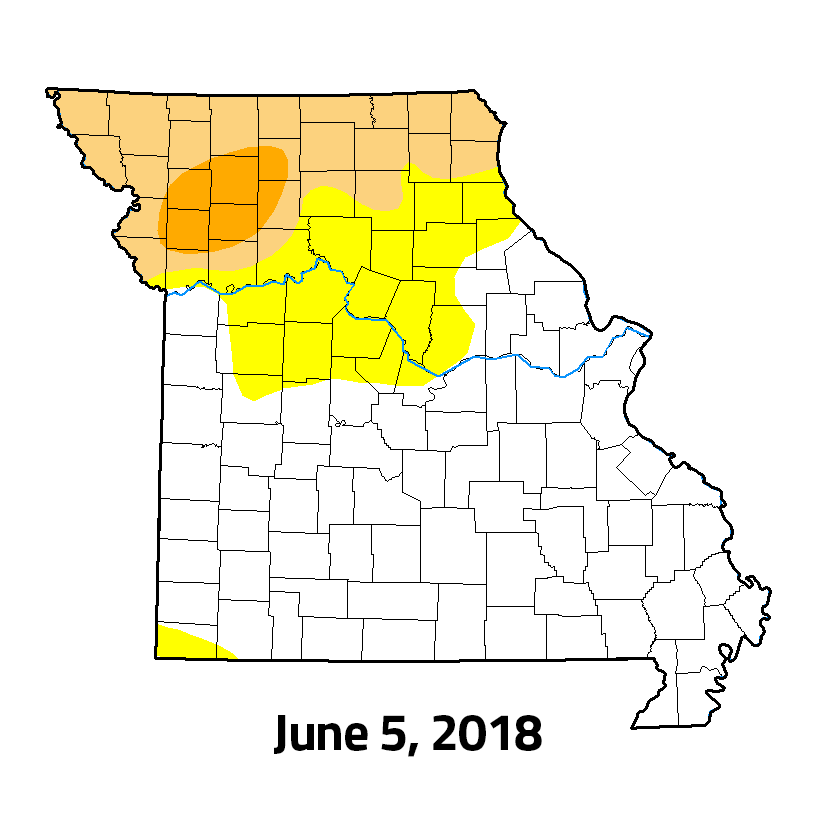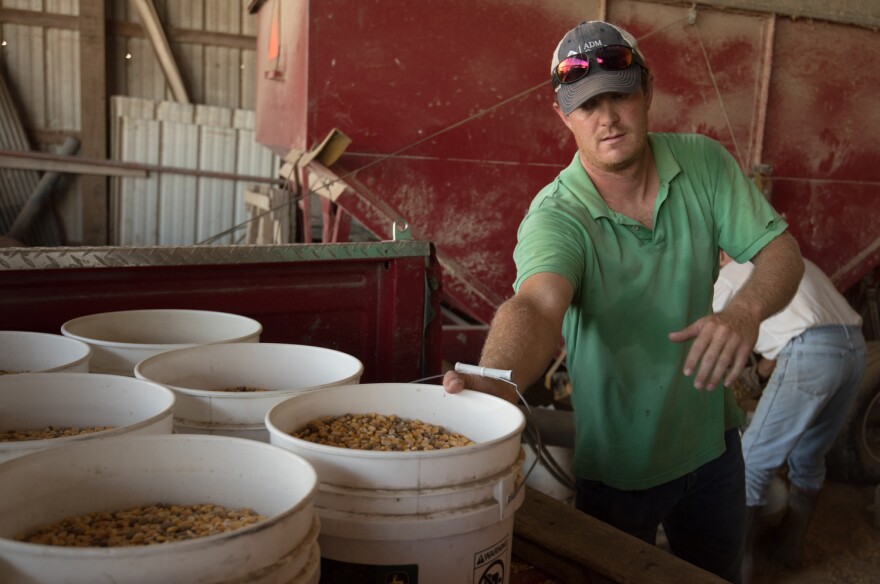Despite recent rainfall, more than half of Missouri is still in a drought, hitting hard at one of the state’s key economic engines: agriculture.
Missouri hay — the primary feed for livestock — has hit its lowest production levels in 30 years, according to the U.S. Department of Agriculture. Ideally, each acre of pasture produces two tons of hay a year, which would be two of those large circular rolls often seen in farm fields. In 1988, the average acre in Missouri only yielded 1.2 tons, and this year it’s been 1.5 tons.
Logan Chrislaw is a 30-year-old cattle producer and row crop farmer in Howard County who is using tractors attached with forklifts to deliver hay every day to roughly 200 head of purebred Charolais beef cattle.
‘Extreme’ drought conditions
The most recent (Sept. 13) drought-monitor report shows most of Howard County experiencing D3, or “extreme” drought conditions — the second-driest rating. But for most of August, the county experienced the worst rating, D4, or “exceptional” drought, and Crislaw’s farm — which is about a 30-minute drive west of Columbia — was within that zone.
He said the cold April, the scorching hot May and the summer-long hot, dry weather have taken their toll.

“The crops started out and really never had enough moisture to take off and thrive like they needed to,” he said. “A lot of our hay crop was about half to two-thirds at best of what it should have been — it was very slow to regrow after we cut it.”
There’s an old saying about corn, that it should be ‘knee-high by the 4th of July.’" Chrislaw’s corn had plenty of height, but: “The biggest issue was the hot weather during pollination, so we actually didn’t get good yields – there weren’t many kernels on the corn.”
And the kernels were smaller due to the lack of moisture.
Chrislaw usually sells his corn, but this year he and his dad chopped up most of it to use as winter feed for the cattle. They’ve also been rationing hay because of how slow it’s been growing this year. But he said they still won’t have enough to feed the cattle this winter.

Chrislaw’s hoping the drought will lessen so that the cattle can live off of any new growth they get before the weather turns cold.
“Right now, the price of the forage is really at a level you can’t insure your profitability, if you will – you’re really going to put yourself in a bad business position buying high-priced feed for the cattle,” he said. “So we don’t have enough feed, we’re putting up everything we can, and scouring everywhere we can to find more.”
He and his dad did catch a small break when a storm front dropped more than an inch of rain over the Labor Day weekend, providing enough moisture to replant some leftover wheat — and then got a bit more relief a few days later from the remnants of Tropical Storm Gordon. But he admits it’ll only help out in the short term.
Drinking water low

Another problem has been drinking water for the cattle, as their ponds got very low in August.
“We have built several ponds on our farm over the last several years trying to stay ahead of things like this – hopefully that’ll be enough, and we won’t have to resort to hauling water,” he said. “I know there are producers in other areas that have completely lost their water sources and have had to haul water.”
Those other areas include a large portion of northwestern Missouri, where livestock owners are being allowed to take up to 5,000 gallons of water a day from water bodies on state conservation and state park lands. Chrislaw has not gotten water from any of those sites, saying the driving distance is too far away to be financially feasible.

Money is tight
And Chrislaw said he probably won’t be able to pay himself for the rest of the year because any extra money he gets will go toward feed.
He’s not alone – livestock owners across the state, even in counties not affected by drought, will have a hard time finding affordable food for their herds.
Loading...
“Hay supply is pretty much done for this year; it’s not going to be improving,” said Bob Garino, the USDA’s statistician for Missouri. “We’ll get another read on it towards the end of the year, see what the final number is, but most of the hay has been cut, and so we’re kind of stuck with that until next year.”
Alfalfa hay is considered the best quality hay for cattle, although non-alfalfa varieties are also commonly used for feed. Garino says right now, alfalfa hay is selling at about $160 a ton, while non-alfalfa hay is going at about $105 a ton. A year ago at this time, they were selling at $150 and $85 a ton, respectively.
Meanwhile, any livestock owners who do buy hay will almost certainly get it from out-of-state growers not affected by the drought, and will pay a lot for it. And not all of them grow corn as back-up feed, as Chrislaw does. Scott Brown, an extension professor at Mizzou, is encouraging livestock owners to consider using alternate feed sources.
“Corn, soy-whole pellets, there’s a lot of alternative feedstuffs that have not moved up as significantly as hay, and we’ll advise producers to think about the flexibility and what they want to feed this winter that might keep costs a little more under control,” Brown said. “If you have extra hay, you might be better off to sell it, even if you need to buy some other feedstuffs.”
He also said it’s too early to put a dollar amount on the negative economic impact from the drought, but he expects government assistance will be made available to anyone who’s suffered catastrophic losses.
While much of the attention has been on rural Missouri, farmers and ranchers in the outskirts of metro St. Louis have also been hit hard.
“I’ve visited with farmers, and they’ve said that their hay, when they mowed their first hay cutting this year, they only were able to get 50 percent [of their normal amount],” said Debi Kelly, who specializes in horticulture for the University of Missouri’s Cooperative Extension office in Jefferson County. “Some of them are not even going to do a second mowing [this year] for their hay and just let it go.”
But conditions in the greater St. Louis area have improved in the first weeks of September. Southern Warren County and the northwest corner of Franklin County are experiencing “moderate” drought — or D1 conditions — while western St. Charles County is currently listed at D0, or “abnormally dry.” The bulk of the greater St. Louis area, including the Metro East in Illinois, is no longer in a drought.
Kelly, along with Brown and Garino, do point to one small bright spot: soybean production has not been harmed too badly by the drought.
So far, the average acre in Missouri has yielded 47 bushels of soybeans this year, compared to 49 bushels last year.
Garino said some late August rainfall in parts of Missouri has helped soybeans in the field rebound, though the final numbers remain to be seen.
“August is a more important month for soybeans,” he said. “They’re putting pods on, and the pods are filling in and gaining weight.”
The National Weather Service’s 90-day forecast for Missouri is showing precipitation to be at normal levels.
Follow Marshall on Twitter: @MarshallGReport






